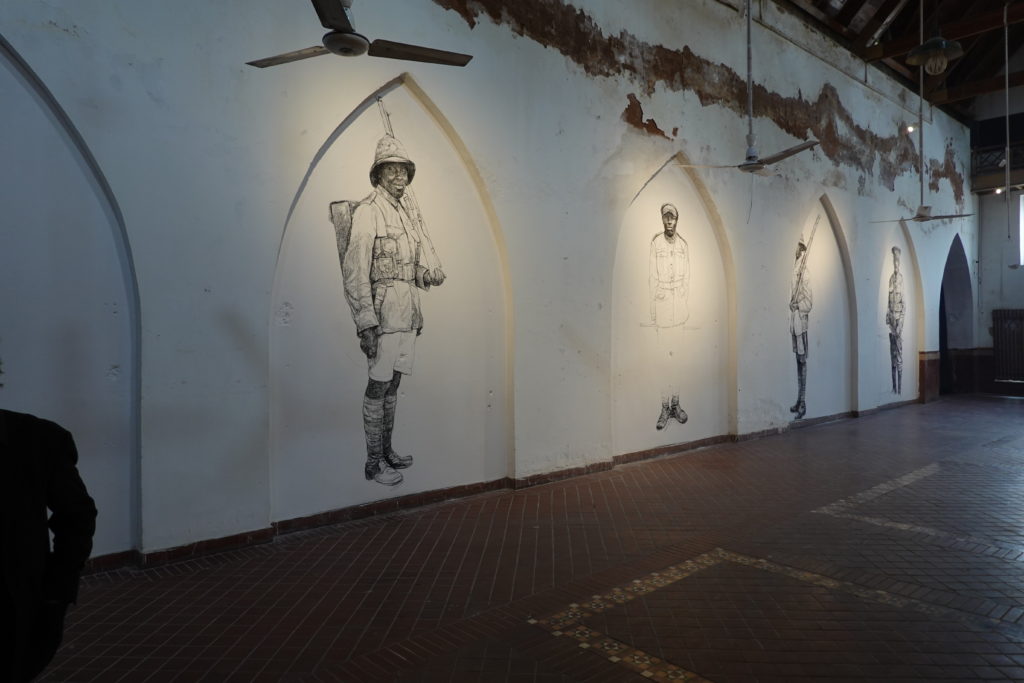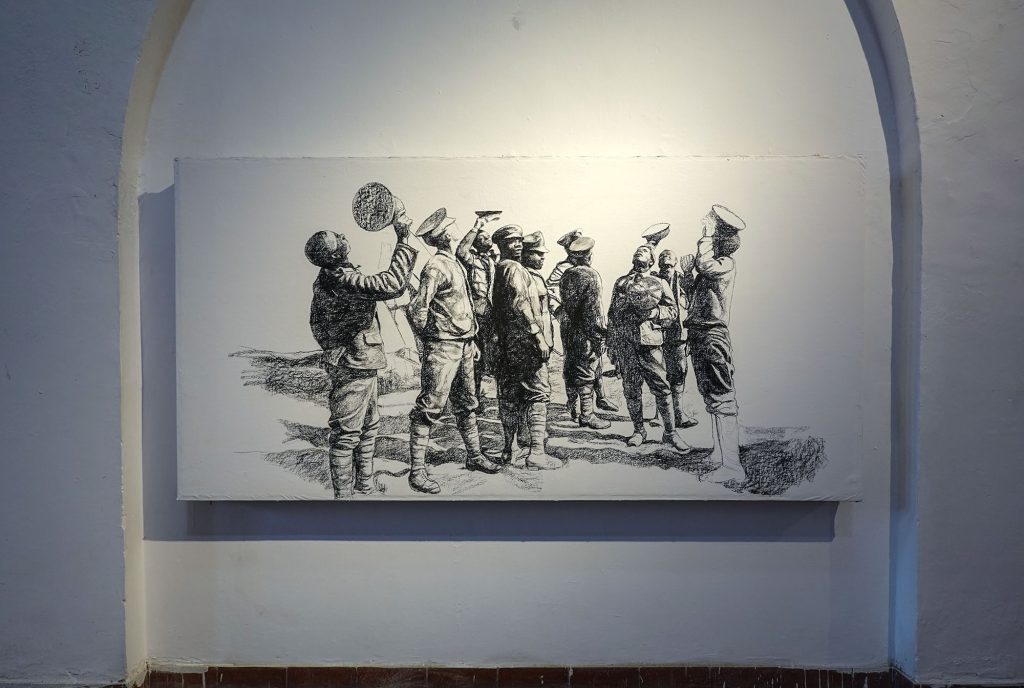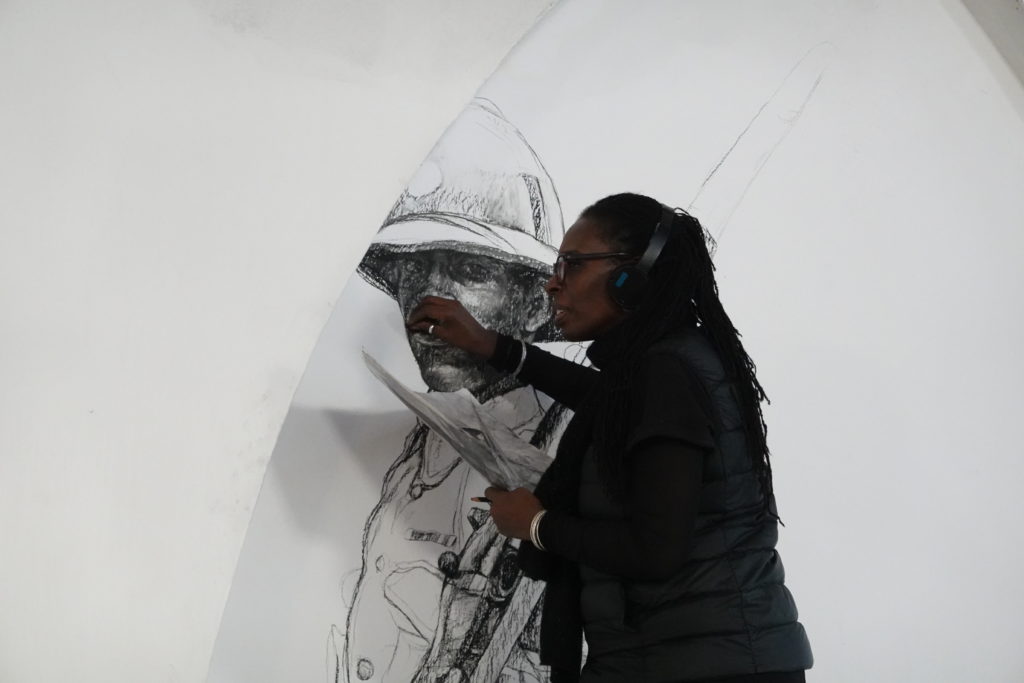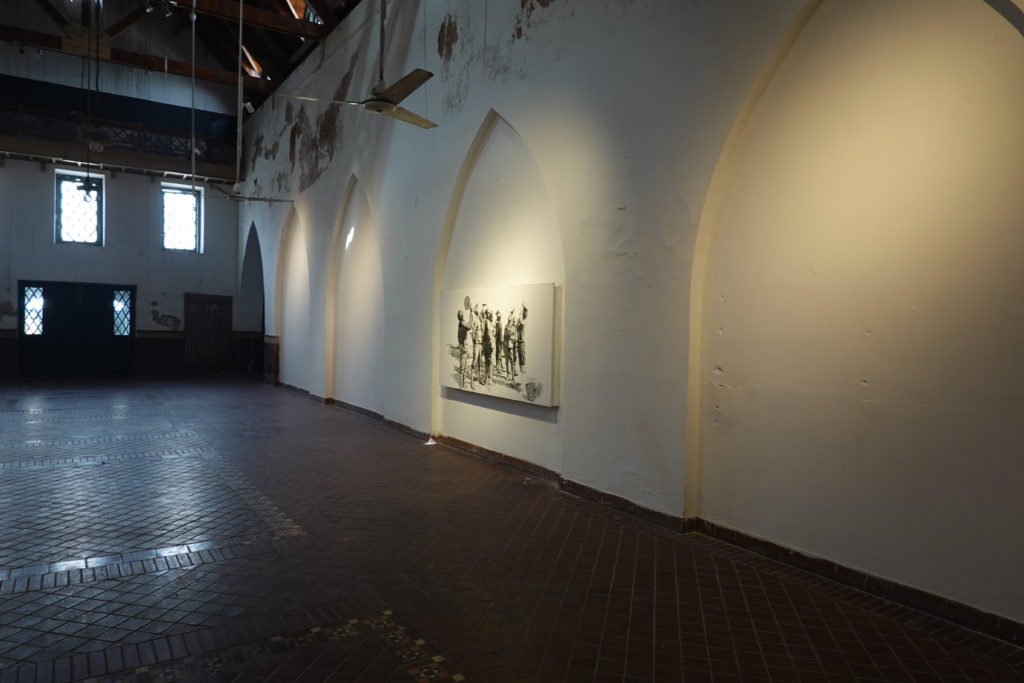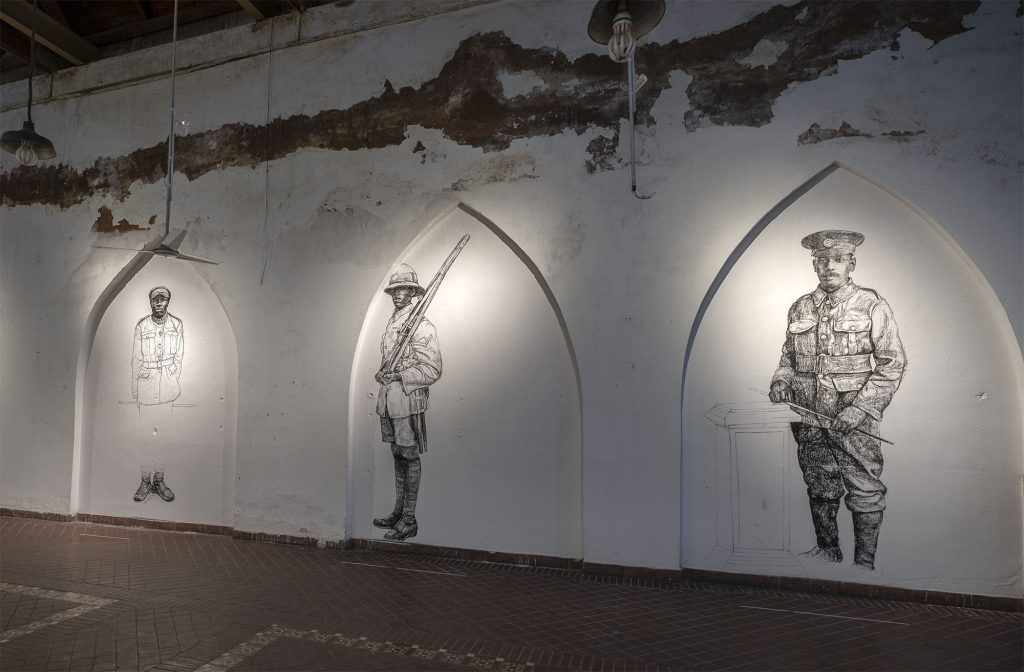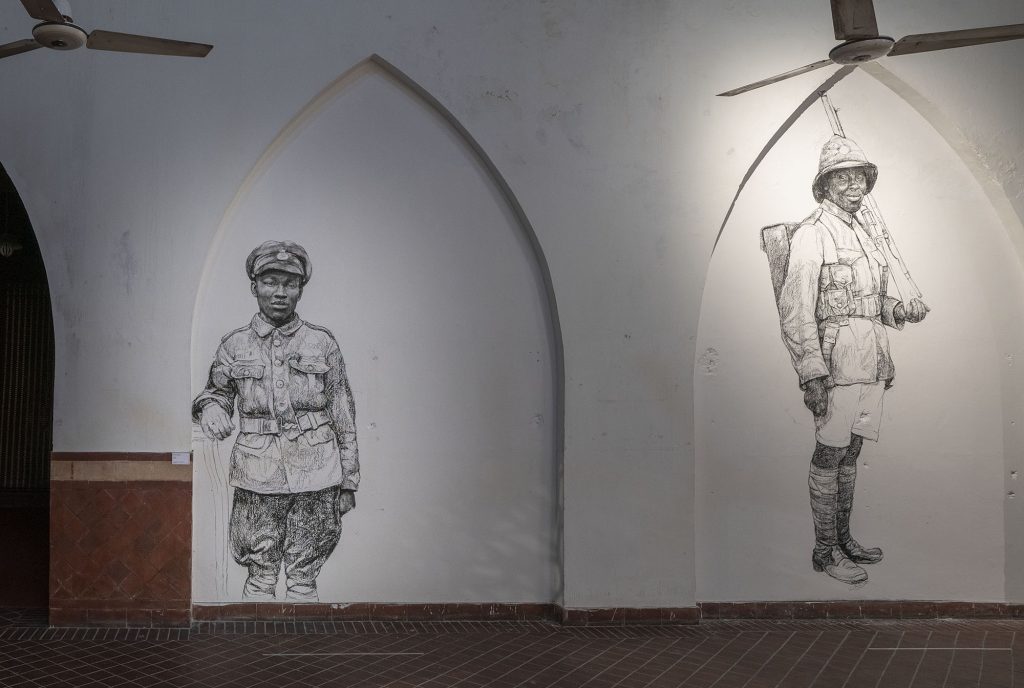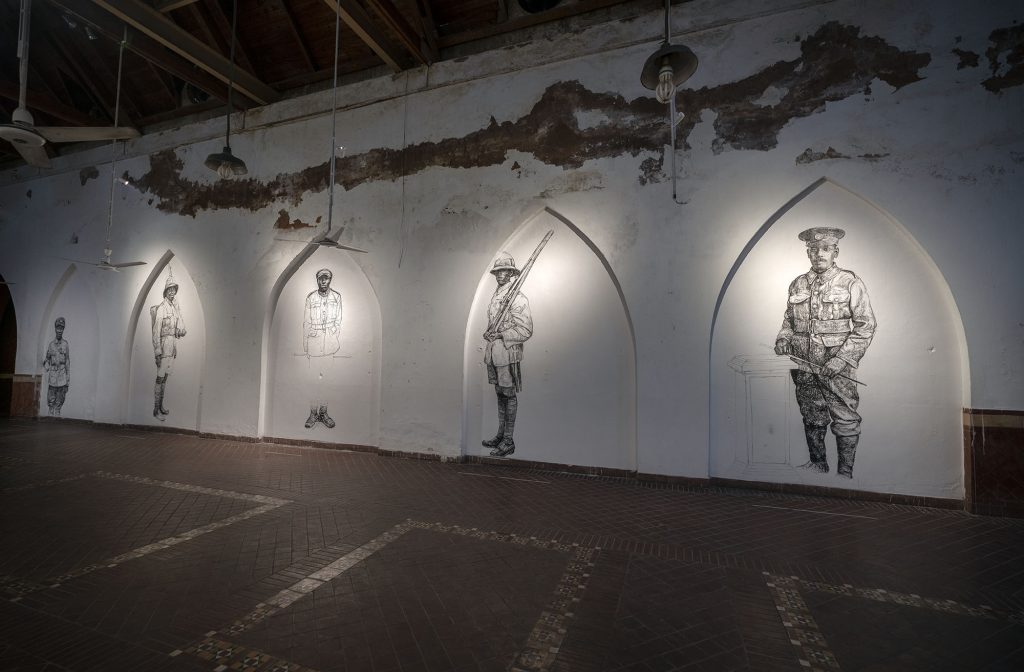Barbara Walker
Alchemy, 2020
Site-specific work, wall drawings, new commission
In Alchemy the British artist Barbara Walker addresses issues of race and segregation in the military. This new series of site-specific, large-scale wall drawings depict soldiers from the Commonwealth in World War I. Acknowledging the contribution of Black servicemen and women to British war efforts is a key concern in Walker’s recent work; she attends to a prevailing absence of representation in our museums and archives, and a missing opportunity to celebrate, respect and remember. The use of erasure and the void within her images signifies what she sees as a gap in the collective consciousness of a nation. History is central to Walker’s practice. In common with her wider body of work, Transcended looks to redress the story with a broader perspective, giving voice where before there was none. Walker references the role of Black soldiers in the First World War, and the thousands of West Indians who volunteered to fight with the British army. Fearing the consequences of empowering Black servicemen to engage and kill a white enemy, the British Government in 1914 initially kept Black soldiers off the frontline and deployed them instead for menial tasks such as digging trenches and moving artillery shells. Once the staggering losses became apparent, the policy changed and Black soldiers were swiftly deployed to fight in combat from 1915. Made in charcoal and ephemeral in nature, Walker’s drawings are striking and bold. They portray soldiers from the British West Indian Regiment who died and were buried in graves in Taranto, Italy, following a mutiny that lasted four days in December 1918. Poignant and affecting, they reference current and recent British conflict alongside historical events of warfare involving Britain and the colonised nations of the British Empire
ماوراء میں برطانوی فنکارہ باربرا واکر فوج میں نسل پرستی اورامتیازی سلوک ایسے معاملات کااحاطہکرتیہیں۔والڈرائنگزپرمشتملیہفنپارہجنِگعظیماولمیںدولِتمشترکہکے سپاہیوں کے کردار کی تصویر کشی کرتا ہے۔ واکر کے حالیہ فن پارے کا بنیادی مقصد یہ ہے کہ جنگ میں فوجی خدمات پر مامور سیاہ فام باشندوں اور عورتوں کی خدمات کو تسلیم کیا جائے؛ واکر ہمارے عجائب خانوں اور آرکائیوز میں ُان لوگوں کی نمائندگی نہ ہونے، ُان کی گراں قدر خدمات کو سراہنے، ان کا احترام کرنے اور ُانہیں یاد کرنے کا موقع ضائع ہونے پر بہت ِفکرمند ہیں۔ واکر اپنی پینٹنگز میں مٹائے جانے اور جگہیں خالی چھوڑ کر قوم کے اجتماعی شعور میں موجود خلا کی نشاندہی کرنا چاہتی ہیں۔ واکر کے کام میں تاریخ کو مرکزی مقام حاصل ہے۔ جیسا کہ واکر کے دیگر فن پاروں کی عام خاصیت ہے، ماوراء نے کہانی کو وسیع تر تناظر میں دیکھا ہے اور ان لوگوں کو آواز دی ہے جن کیپہلےکوئیآوازنہیںتھی۔
واکرجنِگعظیماولمیںسیاہفامسپاہیوںکےکردارکاحوالہ دیتی ہیں اور بتاتی ہیں کہ مغربی ہندوستان کے ہزاروں افراد رضاکارانہ بنیادوں پر برطانوی فوج کے شانہ بشانہ لڑتے رہے۔ سیاہ فام فوجیوں کو سفید فام دشمن کے خلاف لڑانے اور اسے مارنے کے نتیجے میں پہنچنے والی طاقت سے خوفزدہ ہو کر، 1914 میں برطانوی حکومت نے پہلے پہل سیاہ فارم فوجیوں کو اگلے مورچوں سے دور رکھا اور انہیں نچلی سطح کے کاموں پر لگائے رکھا جیسے کہ خندقیں کھودنا اور توپوں کے گولوں کو ایک سے دوسری جگہ منتقل کرنا مگر جب بھاری نقصانات واضح ہو گئے تو پالیسی تبدیل ہو گئی اور 1915 سے سیاہ فام فوجیوں کو فوری طور پر لڑنے کی ذمہ داری سونپی گئی۔
چارکول کوئلے پر مشتمل اورعارضی وقت کے لیے بنائی گئی یہ ڈرائنگز بہت جاذب نظر اور بے باک ہیں۔ وہ برطانوی مغربی ہندوستانی رجمنٹ کے سپاہیوں کی تصویر کھینچتی ہیں جو دسمبر 1918میںچارروزتکرہنےوالیبغاوتمیںمرےاورجواٹلیمیںٹورانومیںمدُفونہیں۔ِدل خراشاورمتاثرکنہونےکیبدولت،یہفنپارےحالیہبرطانویکشیدگیکوجنگکے ُانتاریخی واقعات کے ساتھ جوڑتے ہے برطانیہ اور برطانوی سلطنت کی محکوم قومیں جن کا حصہ رہے ہیں۔
Commissioned by Lahore Biennale Foundation
Acknowledgments: Eman Nadeem, Howrah Batool, and Maham Nadeem


